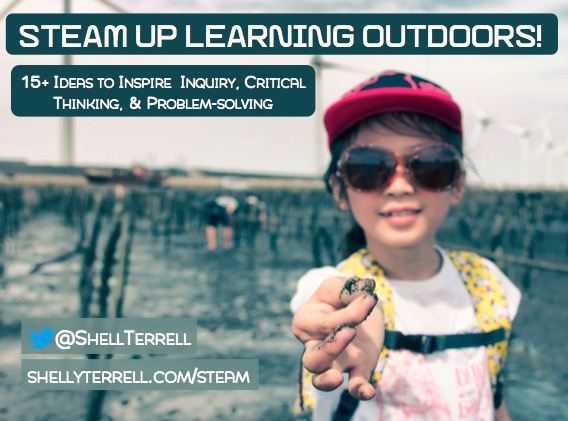“[Science] is more than a school subject, or the periodic table, or the properties of waves. It is an approach to the world, a critical way to understand and explore and engage with the world, and then have the capacity to change that world.” – Barack Obama, Former U.S. President
Many of the missions in my new book, Hacking Digital Learning with Missions, are aimed at inspiring students to think critically, focus on questions versus answers, conduct hands-on research, and make a difference in the world with their innovations. The field of Science, Technology, Engineering, ART and Math (STEM/STEAM) is at the heart of innovation, discovery and curiosity. Sadly, many learners, especially minorities and females, aren’t pursuing careers in STEM fields, because they don’t see themselves as problem-solvers or innovators. One reason is too many curriculums encourage learners to produce answers. The main assessments for schools are multiple choice tests, which punish learners if they don’t choose the right answer provided from a list of narrow options. Providing answers kills the drive to intimately investigate a problem and fall in love with the journey and process of discovering solutions. In the real world, those who transform the world spend a lifetime investigating solutions for problems they are passionate about. Often, they leave records about their research and ideas so that others continue the journey to finding solutions. Below, find STEAM based activities that inspire learners of all ages to explore their outdoor surroundings in creative ways. Find tons of my STEAM inspired lessons and resources collected here.
Get your copy of Hacking Digital Learning, The 30 Goals Challenge, or Learning to Go. Ask me about training your teachers, ShellyTerrell@gmail.com!
STEAM/STEM Resources and Activities
- These are 6 characteristics of a great STEAM lesson I’ve adapted from EdWeek:
- Connect & integrate Science, Technology, Engineering, Art, & Math
- Real world learning
- Hands-on inquiry
- Cooperative learning
- Multiple right answers
- Engineering Design Process (EDP)
- Send them on field research!
- For young learners, they can go on nature walks, observe, and take photos of the nature, ecosystems, animals, and bugs in their environment. Observation logs are just one of the 32 resources in Hacking Learning with Edtech Missions.
- I’ve had students collect water samples with SAWS engineers, bird watch with park rangers, analyze clouds with meteorologists, and fossil hunt with local paleontologists.
- Students can document their observations using the iNaturalist iOS/Android app.
- They can include their observations, photos, and research in interactive field guides or digital scrapbooks using iBooks, EduBuncee, or Book Creator. There is one mission dedicated to this in my book.
- Go on a scavenger hunt! Try these apps and web tools- KlikaKlu app, Goose Chase app, QRWild.com, and the Qr Treasure Hunt Generator.
- Geocaching is where you search for little treasures people hide using GPS coordinates. Many are at local parks or landmarks.
- One of the most important parts of STEAM is guiding students through various processes of inquiry, observation, design, collaboration, and problem-solving. For the following activities below get students to employ the scientific method and the Engineering Design Process. This article by ASCD has a nice visual and information about combining these processes.
- Students collaborate in small groups to invent rides for a future amusement park, construct a course for an art history mini-golf course, or design playground equipment (click here for an additional lesson plan) at their school or for a local park.
- Playground STEAM:
- Students work in pairs to study the math and physics of the slides, swings, or other playground equipment. They create questions, make predictions, test these out, collect data, and come to conclusions.
- Students can measure their shadows at different times of the day. Get them to bring in other objects and draw what they predict the shadows will be depending on the time and location.
- Get them to test different distances and angles with their bodies playing different sports to improve their game.
- Group students to experiment with designing and testing out their designs for creating kites, paper airplanes, rockets, or ships.
- Another mission in my book is about citizen science. Researchers and scientists have created tons of free projects students can join and contribute important research they conduct outdoors and indoors.
- Find projects open to students and the public at SciStarter.com and Zooniverse.org.
- To inspire learning in the summer add them to a digital calendar that students click on to see the activity and receive a digital badge for completing the activity. In a later post I’ll include an example of a Summer STEAM Challenge Digital Calendar for students.
Challenge: Try one of these STEAM inspired activities to motivate students to investigate the science and math in their surroundings.
Subscribe for FREE to receive regular updates!








